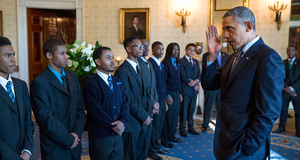The Obama PresidencyWomen's Issues in the Obama Era: Expanding Equality and Social Opportunity Under the Obama Administration
By
2015, Vol. 7 No. 02 | pg. 3/3 | « Leaving a LegacyPresident Obama has made clear in various speeches that his administration believes, “when women succeed, America succeeds,” and that our “society still does not sufficiently value women.”32 In March 2009, Obama signed Executive Order 13506 to create the White House Council on Women and Girls, the first of its kind to ensure all federal agencies account for the needs of women in girls in programs, policies, and legislation. 33 The Council was established directly within the White House to provide a central location for agencies to coordinate a comprehensive response that meets a crucial goal of the administration: to guarantee equal access to opportunity for all people. This Council plays an instrumental role in aggregating data on gendered policies and progress – including education, employment, health, income and crime – to provide the administration with valuable information for crafting new legislation. If the Council is maintained through future administrations, it will be a useful resource for tracking Obama’s policies over time, considering that the impact of certain policies, like an increased minimum wage and universal healthcare access, will not be fully understood for years to come. Working with the Council, Obama has drawn constant attention to violence against women as an issue of health and human rights, on both national and global levels. To illustrate the depth of this epidemic, it should be noted that one in five women have been sexually assaulted in their lifetimes, nearly half before the age of 18. Survivors often struggle with extensive physical and mental health issues, and by some estimates, the economic cost of an attack can range from $87,000 to $240,776.34 Sexual assault on college campuses is especially prevalent, and despite university policies set to deal with assailants, few are arrested or prosecuted.Obama allocated $225 million towards addressing violence against women in the Stimulus Package. A portion of this funding went towards additional police officers and mentoring programs for at-risk youth, among other programs.35 He did not just call for change, he revolutionized the system by putting responsibility on all agencies of the federal government to protect victims and combat the cycle of abuse. Following hearings with Lynn Rosenthal, Obama’s Advisor on Violence Against Women, the president called on over twenty federal agencies to start working on a collaborative strategy, attempting to weave domestic violence prevention into other executive initiatives, like the White House Fatherhood Initiative and the Department of Housing and Urban Development’s campaign to fight homelessness. In October of that year, Obama expanded on these ideas with concrete steps to protect children, improve legal protections for victims, increase sexual assault arrests, and help victims regain financial independence. These policies were followed by the passage of the Child Abuse Prevention and Treatment Act in December, thus verifying that domestic violence and sexual assault were matters that Obama was willing to talk about and fight for in a tangible way. Part of his success can be attributed to minimal conservative pushback in this arena. Fighting these measures would alienate the sought-after female constituency, a move that congressional Republicans could not afford. Even if he had faced opposition, the scope of Obama’s policies to combat violence against women is evidence that this has consistently been a legislative and moral priority. In April 2011, the Office of Civil Rights circulated a “Dear Colleague” letter, calling attention to Tile IX, the federal law prohibiting discrimination on the basis of sex in educational programs or activities operated by recipients of Federal financial assistance.36 Through strong wording, it made clear that this law and its requirements are applicable to sexual violence. It continued with the implication that schools have an immediate responsibility to take effective steps to address sexual violence, followed by an outline of specific procedural requirements pertaining to sexual assault complaints. This included the requirement that all schools have a specific Title IX coordinator, adopt and publish grievance procedures, and provide prompt and equitable resolution of sexual harassment complaints. These ideas were not revolutionary, but the emergence of a federal definition of consent and the standardization of guidelines had resounding effects on the education system. Because college campuses can no longer turn a blind eye to student complaints, schools like Tufts University and the University of Virginia have dealt with federal investigations involving compliance with the law. These schools are not alone; universities across the country are feeling pressure to adhere to new regulations. Coming directly from the Department of Education is a direct indication that this letter was written with Obama’s full support. As these new rules are still unfolding, it is difficult to assess the number of college women affected by these regulations, the extent to which women are safer, and predators are being prosecuted. Critics of Obama’s new policies argue that the federal government has poorly handled this job by placing the responsibility on colleges to handle rape trials, all the while knowing little about criminal investigations. To counter this, I argue that removing the government entirely is also an inadequate solution, as it fails to target the root of the problem and continues on a path of apathy. Whether or not school administrators should be handling sexual assault complaints and policy enforcement will be determined over time as we assess the impact of these changes. If anything, federal policies on college campuses have paved the way for Obama’s multifaceted approach, including the “It’s On Us” and “Not Alone” campaigns and the reauthorization of the Violence Against Women Act. By addressing this as a complex issue with a complex solution, President Obama has built a national conversation around sexual assault on college campuses, a topic frequently shielded from the public eye. Twenty years ago, then-Senator, Joe Biden, authored the Violence Against Women Act (VAWA), bringing national attention to these issues. Annual rates of domestic violence have dropped by an overwhelming 64% since the passage of this act, yet assault against women still exists and necessitates further legal reform.37 In 2013, President Obama reauthorized this bill, providing additional federal support to crisis intervention, counseling, advocacy, medical and social services, law enforcement training, and prosecutorial resources. In his first term, Obama worked to gain congressional support to double the funding for the Sexual Assault Services Program (SASP) under the VAWA, programs that support victims and reach beyond the criminal justice system to provide assistance. One noteworthy aspect of Obama’s campaign included support for traditionally overlooked groups like LGBT individuals, and authorization for tribal authorities to prosecute domestic violence, regardless of the race of the perpetrator. While extensive empirical evidence on the impact of the first authorization of the VAWA is scarce, it has created a public awareness movement, paving the way for procedural changes that encourage victims to speak up. Even if the effects of his policies aren’t tangible today, President Obama’s actions have made women in the U.S. safer while providing victims with support systems on a local level and through the federal government. Building on the VAWA and joining with Vice President Biden, Obama launched the awareness initiative, “It’s On Us,” and the website, notalone.gov, to encourage all Americans to make a personal commitment to become part of the solution. It is significant in the sense that it seeks to prevent sexual assault in the first place and engage men in changing social norms rather than solely provide post-trauma treatment for victims. This campaign by the White House Task Force to Protect Students from Sexual Assault harnessed the support of celebrities, athletes and public figures to encourage college students and campus communities to participate. By joining with and encouraging commitments by partner institutions across the country – including, but not limited to the NCAA, the AAUW, video gaming companies, and major media agencies - the administration has mobilized Americans of all demographics to join in, rather than simply impose a top-down solution. Critics of Obama’s approach argue that this campaign de-politicizes assault and misses the structural causes of violence. While this is true to an extent, Obama’s multipronged strategy towards sexual violence, including the “It’s On Us” campaign, is the first step away from the traditional victim-based approach that may succeed at shifting social and cultural norms. Has Obama Won the War on Women?Obama’s victories for women have been matched by stringent conservative opposition, so much so that one may question whether they oppose the policies or the mere fact that Obama is the driver of this change. Without a nationwide shift in cultural norms supported by both parties, the War on Women will never truly be won. The Republican Party is starkly more misogynous than in the past, exemplified by the fact that the 19th amendment was ratified at a time when Republicans controlled thirty-six state legislatures. Going back further, Barry Goldwater, Republican presidential nominee, argued in 1937 that abortion was “a woman’s business.”38 Demonstrating this historical shift, Mitt Romney, 2012 Republican presidential candidate, once supported Planned Parenthood funding as governor as Massachusetts, yet was forced to re-cant this position as his party platform changed. This War on Women is rightly named because opponents of Obama’s pro-women policies are looking to do real harm with their actions, not just their words, which are equally destructive in that they perpetuate norms and stereotypes. Republicans know that female support is the key to winning elections, something Obama was fully aware of in 2008 and 2012. For this reason, the party emphasized a new message before the 2014 midterm elections proposing that they stand by the American people in a “war for women.” Not only have Republicans opposed Obama on almost every measure discussed in the above analysis – from opposing the historically bipartisan Violence Against Women Act and twice striking down the Equal Pay Act – they have come forward with a proposal that does exactly what Obama has been pushing for: protecting employees who inquire about equal pay.39 This turnaround is applauded, but still testament to my previous point; Republicans have an equal interest in preventing Obama from claiming success as they do in eroding the female right to choose. Conservative pushback may have prevented Obama from implementing his proposals to their fullest extent; however his victories for women are significant and worth celebrating. President Obama has secured new rights for women in the form of Lilly Ledbetter, welfare reform, access to preventative healthcare and a comprehensive approach against sexual violence. At the same time, he has been an active crusader in protecting women from losing hard-won rights to his opposition surrounding reproductive healthcare and economic opportunity. Although it will take the support of a nation to achieve gender equality to its fullest extent, Obama’s actions since taking office in 2008 have improved women’s rights in the United States and ignited a public conversation around formerly stigmatized issues. In the best-case scenario, this will be the stepping stone towards equal access of opportunity for all Americans. References"A Year of Action: Progress Report on Raising the Minimum Wage." White House: Executive Office of the President. August 1, 2014. Accessed November 29, 2014. http://www.whitehouse.gov/sites/default/files/docs/minimum_wage_report2.pdf. "DPCC Fact Check: Republican Myths About the Gender Pay Gap." Democratic Policy and Communications Center. Accessed November 29, 2014. http://www.dpc.senate.gov/docs/fs-112-2-100.pdf. "Executive Order 13506 of March 11, 2009 Establishing a White House Council on Women And Girls." 74, no. 49 (2009). http://www.gpo.gov/fdsys/pkg/FR-2009-03-16/pdf/E9-5802.pdf. "Executive Order 13665 of April 8, 2014 Non-Retaliation for Disclosure of Compensation Information."Federal Register: Presidential Documents79, no. 70 (2014). http://www.gpo.gov/fdsys/pkg/FR-2014-04-11/pdf/2014-08426.pdf. "Executive Order 13658—Establishing a Minimum Wage for Contractors."Federal Register: Presidential Documents79, no. 34 (2014). http://www.gpo.gov/fdsys/pkg/FR-2014-0220/pdf/2014-03805.pdf. "Expanding Medicaid Will Benefit Both Low-Income Women and Their Babies." Center on Budget and Policy Priorities. April 17, 2013. http://www.cbpp.org/files/Fact-SheetImpact-on-Women.pdf. Hartmann, Heidi. "The Economic Stimulus Package IS Women-Friendly." Next New Deal. October 27, 2010. Accessed November 29, 2014. http://www.nextnewdeal.net/economic-stimulus-package-women-friendly. "Invest in Women, Invest in America A Comprehensive Review of Women In the U.S. Economy." Joint Economic Committee. December 1, 2010. http://www.jec.senate.gov/public/?a=Files.Serve&File_id=9118a9ef-0771-4777-9c1f8232fe70a45c. "Jobs and Economic Security for America’s Women." National Economic Council. October 1, 2010. Accessed November 28, 2014. http://www.whitehouse.gov/sites/default/files/Jobs-and-Ecomomic-Security-for-Americas-Women.pdf. Jones, Jeffrey. "Gender Gap in 2012 Vote Is Largest in Gallup's History." Gallup. November 9, 2012. Accessed November 29, 2014. http://www.gallup.com/poll/158588/gender-gap-2012-vote-largest-gallup-history.aspx. Lee, Nancy, and Caira Woods. "The Affordable Care Act: Addressing the Unique Health Needs of Women."Journal of Women’s Health22, no. 10 (2013): 803-06. "Obama Signs Lilly Ledbetter Act." The Washington Post. January 29, 2009. http://voices.washingtonpost.com/44/2009/01/29/obama_signs_lilly_ledbetter_ac.html. "Policy Basics: The Earned Income Tax Credit." Center on Budget and Policy Priorities. January 31, 2014. http://www.cbpp.org/cms/?fa=view&id=2505. "President Barack Obama's State of the Union Address." The White House. January 28, 2014. http://www.whitehouse.gov/the-press-office/2014/01/28/president-barack-obamas-state-union-address. "Rape and Sexual Assault: A Renewed Call to Action." The White House Council on Women and Girls. January 1, 2014. http://www.whitehouse.gov/sites/default/files/docs/sexual_assault_report_1-21-14.pdf. "Remarks by the President at "It's On Us" Campaign Rollout." The White House. September 19, 2014. http://www.whitehouse.gov/photos-and-video/video/2014/09/19/president-obama-speaks-launch-it-s-us-campaign#transcript. "Remarks by the President Upon Signing the Lilly Ledbetter Bill." The White House: Office of The Press Secretary. January 29, 2009. http://www.whitehouse.gov/the_press_office/RemarksbythePresidentUponSigningtheLilyLedbetterBill. Rich, Frank. "Stag Party: The GOP’s Woman Problem Is That It Has a Serious Problem with Women." New York Magazine. March 25, 2012. http://nymag.com/news/frank-rich/gopwomen-problem-2012-4/. Siniscalco, Gary. "Developments in Equal Pay Law: The Lilly Ledbetter Act and Beyond." American Bar. March 1, 2010. http://www.americanbar.org/content/dam/aba/administrative/labor_law/meetings/2010/2010_eeo_007.authcheckdam.pdf. Smith, Sarah. "House GOP Touts ‘war for Women’." Politico. July 30, 2014. http://www.politico.com/story/2014/07/house-gop-empower-women-families-109542.html. "Statement of Administration Policy H.R. 1338 – To Amend the Fair Labor Standards Act of 1938." Executive Office of The President: Office of Management and Budget. July 30, 2008. http://www.whitehouse.gov/sites/default/files/omb/legislative/sap/110-2/saphr1338-r.pdf. "The George W. Bush Institute Announces New Women’s Health Initiative." George W. Bush Presidential Center. September 13, 2011. http://www.bushcenter.org/press-releases/2012/09/14/george-w-bush-institute-announces-new-women’s-health-initiative. "The Erosion of Hard-Won Gains for Women Under the Bush Administration and an Agenda for Moving Forward." National Women's Law Center. April 1, 2004. http://www.nwlc.org/sites/default/files/pdfs/AdminRecordOnWomen2004.pdf. "The President's Proposal to Expand the Earned Income Tax Credit." White House: Executive Office of the President and U.S. Treasury Department. March 1, 2014. http://www.whitehouse.gov/sites/default/files/docs/eitc_report.pdf. "Usual Weekly Earnings of Wage and Salary Workers Third Quarter 2014." Bureau of Labor Statistics. October 24, 2014. http://www.bls.gov/news.release/pdf/wkyeng.pdf. "Women In America: Crime and Violence." The White House. Accessed November 30, 2014. http://www.whitehouse.gov/sites/default/files/rss_viewer/WomenInAmerica_CrimeViolenceFactsheet.pdf. Endnotes1.) . See "Jobs and Economic Security for America’s Women" (2010) for additional information. Because U.S. Census Bureau and U.S. Labor Bureau use different measures to analyze the pay gap – for example, BLS data does not included self-employed workers - professionals dispute the extent of this gap. Census Bureau data from 2012 validates this claim of the 77 cent wage gap, yet some question how much of this is due to intentional discrimination. 2.) . Jones 2012. 3.) . President Barack Obama's State of the Union Address (2014). 4.) . Lee and Woods 2013. 5.) . See “Policy Basics: The Earned Income Tax Credit” (2014) for further information on the EITC. The EITC has proven to be a more effective tool at raising employment among low-income single mothers than either welfare reform or a growing economy. 6.) . The Erosion of Hard-Won Gains for Women Under the Bush Administration and an Agenda for Moving Forward (2004). 7.) . The George W. Bush Institute Announces New Women’s Health Initiative (2011). 8.) . Obama Signs Lilly Ledbetter Act (2009). 9.) . See Brake and Grossman 2007, for an excellent summary of case. 10.) . DPCC Fact Check: Republican Myths About the Gender Pay Gap. 11.) . Ibid. 12.) . Remarks by the President Upon Signing the Lilly Ledbetter Bill (2009). 13.) . Siniscalco 2010. 14.) . Statement of Administration Policy H.R. 1338 – To Amend the Fair Labor Standards Act of 1938 (2008). 15.) . Executive Order 13665 of April 8, 2014 Non-Retaliation for Disclosure of Compensation Information (2014). 16.) . The Paycheck Fairness Act is considered an extension of the Equal Pay Act of 1963. 17.) . Jobs and Economic Security for America’s Women (2010). 18.) . Hartmann 2010. 19.) . Goldfarb 2014. 20.) . See “A Year of Action: Progress Report on Raising the Minimum Wage" (2014) for additional information on this statistic, including that it is supported by over 600 economists. 21.) . Executive Order 13658—Establishing a Minimum Wage for Contractors (2014). 22.) . The President's Proposal to Expand the Earned Income Tax Credit (2014). 23.) . Policy Basics: The Earned Income Tax Credit (2014). 24.) . The President's Proposal to Expand the Earned Income Tax Credit (2014). 25.) . Jobs and Economic Security for America’s Women (2014). 26.) . Compared to $65 increases in weekly median earnings for men. See, Usual Weekly Earnings of Wage and Salary Workers Third Quarter 2014 (2014) for more information. 27.) . The Census Bureau uses different measures to analyze the pay gap than the Bureau of Labor Statistics, which unlike the Census Bureau, includes weekly wages and does not account for people who are self-employed. 28.) . Expanding Medicaid Will Benefit Both Low-Income Women and Their Babies (2013). 29.) . To put this into context, Medicaid covers over 40% of births in the U.S. 30.) . Invest in Women, Invest in America: A Comprehensive Review of women in the U.S. Economy (2010). 31.) . COBRA is equivalent to the Consolidated Omnibus Budget Reconciliation Act. 32.) . Remarks by the President at "It's On Us" Campaign Rollout (2014). 33.) . Executive Order 13506 of March 11, 2009 Establishing a White House Council on Women And Girls (2009). 34.) . Rape and Sexual Assault: A Renewed Call to Action (2014). 35.) . Women In America: Crime and Violence. 36.) . A “Dear Colleague” letter is official correspondence from a Member, Committee, or officer of the U.S. House of Representatives or U.S. Senate to another congressional office, often used to cosponsor, support or oppose a bill. 37.) . Rape and Sexual Assault: A Renewed Call to Action (2014). 38.) . Rich 2012. 39.) . Smith 2014. Suggested Reading from Inquiries Journal
Inquiries Journal provides undergraduate and graduate students around the world a platform for the wide dissemination of academic work over a range of core disciplines. Representing the work of students from hundreds of institutions around the globe, Inquiries Journal's large database of academic articles is completely free. Learn more | Blog | Submit Latest in Women's & Gender Studies |


















